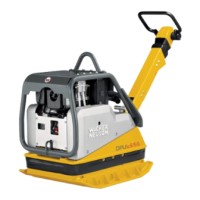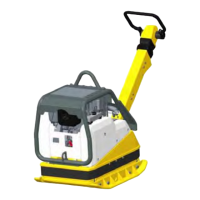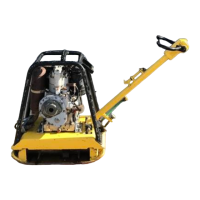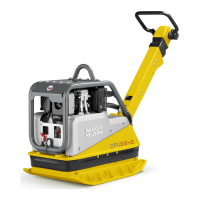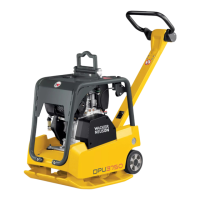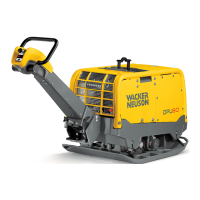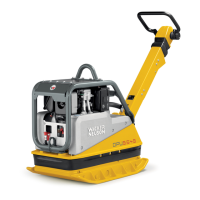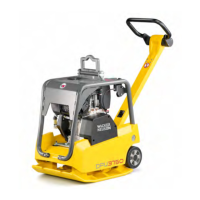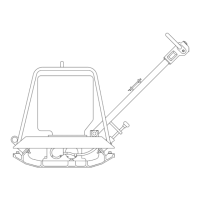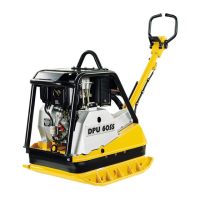
Do you have a question about the Wacker Neuson DPU 6055 and is the answer not in the manual?
| Brand | Wacker Neuson |
|---|---|
| Model | DPU 6055 |
| Category | Power Tool |
| Language | English |
Details about the EPA-certified engine and cautions regarding adjustments.
Warning about chemicals in exhaust known to cause cancer/birth defects in California.
Emphasizes reading and following safety instructions for safe operation.
Guidelines for operator age, fitness, training, and machine usage.
Details on operating levers, breaks, refueling, and proximity to hazards.
Covers keeping clear of moving parts, working near edges, soil capacity, and protective clothing.
Includes avoiding hand injuries, ensuring stability, proper storage of trolley.
Covers pre-operation checks of controls and safety devices.
Covers using original parts, modifications, switching off drives, and battery disconnection.
Addresses hydraulic lines, reinstalling safety devices, and avoiding water hosing.
Covers transport loading, securing, and ramp safety.
Requirement for annual checks by skilled technicians.
Details item number, dimensions, weight, and power transmission for DPU 6055.
Provides fuel, consumption, tank capacity, battery, alternator, starter, and DC voltage specifications.
Details hydraulic oil type, quantity, and lubricating grease specifications.
Describes suitability for various soil types and compaction of paving stones/concrete blocks.
Illustrates and states the maximum tilt angle allowed for operation.
Explains how vibration is generated and controlled for forward, standstill, and reverse motion.
Details automatic V-belt pulley, vibration damping, and engine starting mechanism.
Covers lifting, fuel handling, and securing the machine for transport.
Details proper use of lifting points and securing the machine on vehicles.
Factors affecting compaction depth and the need for tests.
Guidelines for compacting on gradients, including approach direction and tilt limits.
Essential checks for engine oil and fuel before starting the machine.
Lists specific cases and steps for reactivating oil pressure control.
Warnings about exhaust fumes, switching off engine during maintenance, and starter sprays.
Step-by-step guide for starting the engine using the electric starter.
Post-start checks for charge lamp, acoustic alarm, and air filter indicator.
Instructions for preparing and using the safety starting crank.
Detailed method for turning the safety crank to start the engine.
Handling back kicks, stopping the engine, and checking the air filter after starting.
Specific steps for starting the engine in temperatures below -5 °C.
Requirements for jumper cables and the correct sequence for jump-starting.
How to control direction and speed using the shift lever.
Instructions for fitting protective screws when not using extension plates.
Correct method for stopping the engine without damaging components.
Lists components and their recommended maintenance intervals.
Details on checking and replacing engine oil and the oil filter.
Step-by-step guide for draining old oil and replacing the oil filter.
Final steps for cleaning, sealing, refilling oil, and checking for leaks.
Procedures for inspecting and cleaning the air filter system and its components.
Steps for removing, cleaning, inspecting, and replacing the air filter element.
Procedure for inspecting and draining the water separator in the fuel system.
Steps for replacing the fuel filter, including fuel line handling and leak checks.
Importance of checking screwed connections and not adjusting governor/injection system screws.
How to check battery acid level and ensure terminal safety.
Procedures for checking hydraulic oil level and venting the hydraulic control system.
Steps for checking and topping up oil in the exciter unit.
Detailed steps for draining and refilling the exciter oil, including safety warnings.
Guidelines for checking V-belt wear and procedure for replacement.
Causes and remedies for low forward or reverse speeds and no reverse motion.
Identifies leaks and defective hoses as causes for hydraulic oil loss.
Troubleshooting for a charge control lamp that won't extinguish or a buzzing buzzer.
Lists potential causes like ignition lock, starter, battery, and oil level for engine starting failure.
Lists and describes the components shown in the electrical wiring diagram.
Identifies various labels on the machine, including air cleaner, starting procedure, and warnings.
Details the conformity assessment, notified body, and applicable directives for the equipment.

